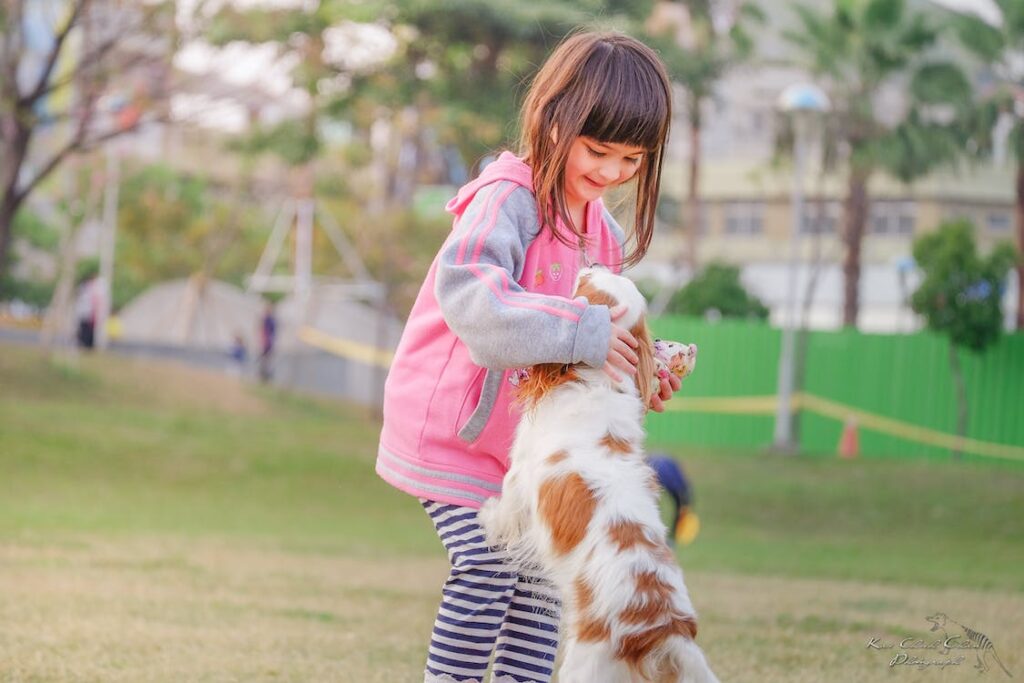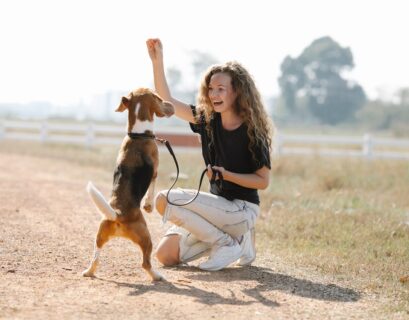The Heartwarming Bond Between Kids and Dogs – A Tale of Unconditional Love and Life Lessons”
As we explore the wonders of the dogs and children bond, we find ourselves drawn to the profound emotional development that blossoms within our little ones. Witnessing a child gently stroke a dog’s fur with tender care, we see how empathy and compassion sprout naturally from these interactions. With their unwavering loyalty and unconditional love, dogs become invaluable companions in a child’s journey of self-discovery.
This special friendship benefits our children’s physical health and well-being in addition to their emotional well-being. In an era of digital distractions, dogs are delightful catalysts for outdoor adventures and play. Whether it’s a game of fetch in the park or a stroll around the neighborhood, the companionship of a dog encourages our children to revel in the joys of movement and embrace the great outdoors.
Moreover, the bond between kids and dogs proves to be an exceptional teacher of social skills and communication. The responsibilities of pet ownership instill a sense of accountability in children, teaching them to care for another living being and understand the importance of meeting their needs. As children learn to decipher their furry friend’s cues and body language, they sharpen their ability to read emotions, fostering an authentic connection built on understanding and trust.
However, while we celebrate the myriad benefits, we must also be diligent in creating a safe environment for kids and dogs. Knowledge is the bedrock of safety, and as parents, guardians, and caretakers, we must educate ourselves about dog behavior and teach our children the do’s and don’ts when interacting with their canine companions. Ensuring children know how to approach a dog and give them space when needed is crucial in preventing unnecessary stress or discomfort.
Just as important as education is the establishment of boundaries and respect. Setting clear guidelines for our children and helping them understand the dog’s limits fosters harmonious coexistence. Teaching kids not to disturb a dog while eating or sleeping and recognizing when the dog may need a break from play creates an environment where both parties feel comfortable and secure.
Positive reinforcement-based training methods are key in shaping a well-behaved and happy canine companion to solidify this bond further. When children are involved in training and are given the tools to communicate effectively with their dogs, they develop a sense of responsibility that transcends their pet relationship into one of true friendship and understanding.
Recognizing signs of stress or anxiety in dogs enables us to step in and create a calm and supportive environment. Additionally, we must be proactive in dealing with any aggressive behavior, seeking professional help to ensure the child’s and the dog’s safety and well-being.
By committing to responsible pet ownership and parenting, we can unlock the full potential of this extraordinary friendship. Careful consideration of the dog’s temperament and the family’s lifestyle should guide the decision to add a dog to the family. Once the dog becomes a beloved household member, involving children in age-appropriate care tasks imparts invaluable life skills and strengthens their bond.
Understanding the Benefits of the Dog and Children Bond
Emotional Development

The connection between dogs and children extends far beyond mere companionship. Interacting with dogs can profoundly impact a child’s emotional development, fostering qualities such as empathy, compassion, and emotional intelligence. As children care for and nurture their canine friends, they learn to understand and respond to the needs and emotions of another living being. This heightened sensitivity to their furry companion’s feelings translates into a deeper understanding of empathy and compassion towards others, human or animal alike.
Moreover, dogs provide a comforting and soothing presence for children, reducing stress and anxiety. When a child finds solace in the warm embrace of a dog, a special bond forms, allowing them to confide their worries and fears without fear of judgment. As a result, children often experience reduced anxiety levels, better emotional regulation, and improved overall well-being through their unique bond with their canine confidants.
B. Physical Health and Exercise
A dog’s boundless energy and enthusiasm can transform children’s physical health and activity levels. Owning a dog encourages regular outdoor activities and exercise, as children happily engage in playful games of fetch, joyful runs, and leisurely walks with their furry companions. This increased physical activity promotes physical fitness and fosters a love for the outdoors and a deeper appreciation for the natural world.
Beyond the general health benefits, the presence of dogs can be particularly advantageous for children with certain health conditions or disabilities. Dogs can serve as remarkable therapy and support animals, offering comfort and companionship to children facing various challenges. Dogs’ unconditional love and non-judgmental nature create an environment where children feel safe and understood, contributing to their emotional resilience and overall well-being.
Social Skills and Communication
The bond between children and dogs is a dynamic training ground for enhancing social skills and communication abilities. Caring for a dog involves a sense of responsibility that extends beyond oneself, teaching children the importance of fulfilling the needs of another living being. As they engage in daily routines, such as feeding, grooming, and playtime, children develop a heightened sense of accountability and learn the rewards of nurturing and caring for their furry friends.
Furthermore, dogs possess an uncanny ability to communicate nonverbally, and children quickly pick up on these cues. Understanding a dog’s body language and recognizing the subtleties of its expressions enable children to develop a language of empathy and understanding that goes beyond words. This intuitive form of communication nurtures trust and deepens the emotional connection between children and their canine companions, encouraging them to become more empathetic and compassionate in their interactions.
Building a Safe Environment for Dogs and Children
Education and Supervision

Education and supervision play a critical role in fostering a positive relationship between kids and dogs. Both parents and children must be educated about dog behavior, body language, and appropriate ways to interact with their four-legged friends. Understanding how to approach a dog gently and respectfully, and recognizing signs of stress or discomfort in dogs, ensures a safe and enjoyable environment for all.
Moreover, constant supervision during interactions between young children and dogs is essential. While the bond between them is precious, it is also necessary to prevent any unintentional harm arising from misunderstandings or overexcitement. Responsible adults must always be present to guide and oversee these interactions, providing an extra layer of protection for both the child and the dog.
B. Boundaries and Respect
Establishing clear boundaries for children and dogs within the household is paramount to maintaining a harmonious relationship. Children should be taught to respect the dog’s space, especially when eating or resting. Understanding that dogs also need personal space and time fosters mutual respect between the child and their canine companion.
Additionally, teaching children to respect the dog’s food and toys helps prevent conflicts and ensures the dog feels secure and protected in their environment. By instilling a sense of responsibility in children to care for their furry friends, they learn the value of setting boundaries and maintaining a harmonious coexistence.
Positive Reinforcement Training
Creating a positive and safe environment for kids and dogs involves promoting good behavior through positive reinforcement training methods. Reward-based training encourages desired behavior in dogs and empowers children to participate in their canine companion’s training journey. This collaboration fosters a sense of teamwork and strengthens the bond between the child and their beloved pet.
As children learn to train their dogs, they better understand their needs, desires, and capabilities. This understanding nurtures a profound connection founded on trust, love, and respect, enriching the child’s emotional development and the dog’s well-being.
Identifying and Addressing Potential Risks
Recognizing Signs of Stress and Anxiety

Parents and caregivers must be vigilant in recognizing signs of stress and anxiety in dogs to ensure the safety and comfort of both children and dogs. Canine communication is largely nonverbal; dogs express their emotions through body language and vocalizations. Educating parents and children about these cues is crucial in preventing conflicts and ensuring positive interactions.
Signs of stress in dogs may include panting, trembling, yawning, lip licking, or attempts to avoid eye contact. Vocalizations such as growling or whining may indicate the dog is feeling uneasy. When a dog displays these signs, it is essential to give them space and time to relax, respecting their need for a break.
B. Preventing Aggressive Behavior
Understanding the factors that may contribute to aggressive behavior in dogs is fundamental in creating a safe environment for both children and dogs. While dogs are typically loving and gentle, certain triggers may cause them to become defensive or anxious, leading to aggressive behavior.
Parents and caregivers must proactively address these triggers, such as resource guarding or fear of certain situations. Training and desensitization exercises can be effective in helping dogs overcome these challenges and build confidence. However, if aggressive behavior persists, seeking professional help from a qualified dog trainer or behaviorist is essential to ensure the safety of both the child and the dog.
Dealing with Fear and Allergies
For some children, the fear of dogs may initially hinder their ability to form a bond with these lovable creatures. Overcoming this fear requires patience and gentle exposure to dogs in a positive and controlled environment. Encouraging positive interactions and allowing the child to become comfortable in the presence of dogs help them develop a sense of trust and confidence around their canine friends.
Additionally, for families with children prone to pet allergies, careful management is key to maintaining a healthy relationship between dogs and children. Regular grooming, vacuuming, and maintaining a clean living space can help reduce allergens. Additionally, consulting with a pediatrician or allergist can provide valuable guidance on managing allergies and ensuring the child’s well-being.
Encouraging children to participate in their dog’s care actively reinforces the concept of responsibility and nurtures a sense of empathy and understanding. Whether feeding, grooming, or taking them for walks, these shared activities strengthen the bond between child and dog, forging a partnership built on love and mutual respect.
Furthermore, teaching children about nonverbal communication is essential for interacting with dogs and navigating social interactions with people. The ability to read body language and interpret emotions lays the groundwork for building meaningful connections with others, promoting social harmony and understanding.
We must set a good example for our children as we work to create an environment where dogs and children can coexist. Children internalize these values by demonstrating respect and kindness to their furry friends, learning to treat animals and others with the same empathy and compassion they receive.
Responsible Pet Ownership and Parenting
Bringing a dog into a family with children is a decision that can profoundly impact everyone involved. It is about welcoming a furry companion into the household and fostering a harmonious and fulfilling relationship between the child and the dog. Responsible pet ownership and parenting play a crucial role in ensuring that this unique bond flourishes, bringing joy, love, and valuable life lessons to the lives of both children and dogs.
Preparing for Dog Ownership
Before embarking on the journey of dog ownership, families must carefully consider the responsibilities and commitments that come with it. Dogs require daily care, attention, and love, and involving children in this decision-making process can help them understand their responsibilities.
Parents should assess their family’s lifestyle and determine if they have the time and resources to dedicate to a dog’s care. Dogs thrive on routine, so families must be prepared to provide consistent care, including feeding, exercise, grooming, and regular veterinary visits.
Moreover, choosing a dog with a suitable temperament for a household with children is paramount. Some dog breeds are naturally more patient, gentle, and tolerant of young children, making them ideal companions. Conducting thorough research and seeking advice from animal behaviorists or reputable breeders can help families find a dog whose personality aligns well with family dynamics.
B. Involving Children in Dog Care
One of the most rewarding aspects of dog ownership is involving children in caring for their four-legged friends. Age-appropriate dog care tasks allow children to develop essential life skills, such as responsibility, empathy, and commitment.
Feeding is a fundamental aspect of dog care that children can be involved in from a young age. Measuring and preparing a dog’s meals instills a sense of duty and accountability as children learn to provide for their canine companions’ basic needs.
Grooming is another aspect that can be shared between children and dogs. Brushing the dog’s fur keeps its coat healthy and strengthens the bond between child and dog. As children learn to groom their furry friends gently, they develop an understanding of the importance of nurturing and caring for another living being.
Physical exercise is essential for a dog’s well-being, and involving children in playtime and walks encourages a healthy and active lifestyle. These shared activities create lasting memories and reinforce the companionship between the child and their beloved pet.
While involving children in dog care, they learn invaluable lessons about commitment and empathy. Caring for another living being instills a sense of duty and dedication, teaching children the importance of following through on their responsibilities. Additionally, understanding and responding to a dog’s needs fosters empathy as children learn to consider and cater to the emotions and well-being of their furry friends.
Conclusion
The bond between dogs and children is a treasure trove of love, joy, and mutual growth. Nurturing this special relationship through responsible pet ownership and parenting is essential for ensuring a positive and safe experience for both children and dogs.
By preparing for dog ownership with careful consideration and choosing a dog with a suitable temperament, families can create an environment where both the child and the dog can thrive harmoniously. Involving children in age-appropriate dog care tasks instills vital life skills and strengthens the bond between child and dog, fostering empathy, commitment, and a sense of responsibility.
The dog’s and children’s bond is a beautiful journey of emotional growth and empathy. Children who grow up with dogs as their companions often develop a profound understanding of the importance of kindness, compassion, and unconditional love. These lessons shape their character and influence how they interact with others.
Furthermore, involving children in the care of their canine companions nurtures a sense of responsibility that extends beyond the realm of pet ownership. The commitment required in caring for a dog teaches children the value of dedication and follow-through, which are essential for success in various aspects of life.
Responsible pet ownership and parenting go hand in hand, as parents and caregivers lead by example, showcasing love and respect for their furry family members. Children observe and internalize these values, learning to treat animals and all living beings with kindness and empathy.
However, the journey of responsible pet ownership has its challenges. As families embrace the joys and responsibilities of having a dog, remaining committed to continuous learning and awareness is crucial. Staying informed about canine behavior, health, and well-being allows parents to make informed decisions and provide the best care for their furry companions.
Additionally, their interactions with dogs may change as children grow and mature. Parents should be attuned to these changes and provide guidance and supervision as needed. Teaching children to recognize and respect the dog’s boundaries ensures that the relationship remains positive and safe for both parties.
In our ever-evolving world, fostering a positive and safe bond between dogs and children takes on a broader societal significance. As we nurture compassionate and responsible individuals, we contribute to a future generation that values the well-being of all living beings and understands the interconnectedness of life on our planet.
As the sun sets on another day of laughter, play, and companionship between dogs and children, let us carry the lessons learned into the tapestry of our lives. Let us continue to embrace the love and joy that dogs bring into our homes, while also advocating for responsible pet ownership and parenting in our communities.
In this shared journey of love and companionship, let us remember that the dogs and children bond is a testament to the beauty of our shared existence. As we cherish the cherished memories and embrace the lessons learned, we honor the profound connection between two innocent souls – the boundless, loyal heart of a dog and the tender, growing heart of a child.








